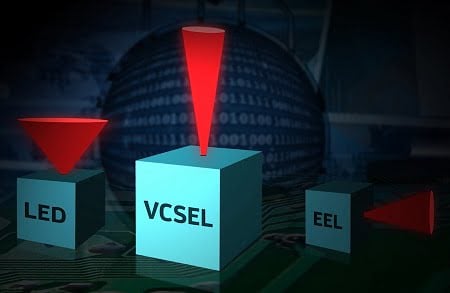EU Scientists are harnessing next-generation lasers to create light-speed broadband connections and to remove the data bottlenecks that could cause the internet to grind to a halt as demand increases.
The EU-funded researchers from nine countries (Italy, Spain, The Netherlands, Finland, Germany, Israel, France, Japan, and South Korea) and 14 different organizations, call themselves PASSION — Photonic technologies for progrAmmable transmission and switching modular systems based on Scalable Spectrum/space aggregation for future agIle high-capacity metrO Networks.
The researchers are using vertical-cavity surface-emitting laser (VCSEL) sources with photonic integrated circuits, optical switches, and semiconductor optical amplifiers to develop long-wavelength, high-capacity communications. This could pave the way for light-speed metropolitan connectivity and power new smart services like future gaming and on-demand TV.
VCSELs are cheap to manufacture and more efficient than traditional laser sources. The super-fast components have the potential to revolutionize smart services that consume enormous amounts of data for connected citizens of the future. With transmission rates up to 112 Tb/s, sending 28,000 HD movies would take as little as 1 second.

VCSELs emit vertically, giving compactness to the laser. They also consume very low energy. Courtesy of PASSION.
VCSELs have been used in data communications for short-distance connections in intra-data centers. Using these infrared lasers for long-wavelength and high-capacity communications is a new concept.
The PASSION team chose to exploit VCSEL light sources because of their high transmission efficiency and minimal power consumption.
“VCSELs could be the next big leap in metro communications," said PASSION project manager Paola Parolari. "They are already employed widely in data communications, in intra-data center short-distance connections, for example."
“VCSELs are a bit of a buzz word at the moment. They have the advantages of low driving current, high light-power conversion efficiency and high directivity," said project coordinator, Pierpaolo Boffi. “This makes them an ideal choice for transmitting huge amounts of data in a low-cost, energy-efficient way.”
Boffi told Photonics Media that the PASSION team has ambitions to reduce the current power consumption of the internet by ten times their current rates.
“The success of PASSION could provide a new technology for the very high capacity optical transport with reduced footprint and energy consumption,” he said.
U.S. internet technology company, Cisco predicts that internet traffic will grow to an unprecedented 3.3 trillion gigabytes per year between 2016 and 2021.
“If we are serious about having super-connected citizens, using broadband services such as telework, improved entertainment such as HD and 3D TV on demand, or gaming, remote health care, assisted living, enhanced social networking, ‘eLearning’ for example, we need a fiber optic network that is leagues ahead of where it is now,” said Boffi.
PASSION will develop new transmission, detection, and routing solutions as well as an advanced network architecture based on VCSELs.
The PASSION consortium has secured a grant of €7,535,747 from the European Commission under the H2020 funding program and was funded under the Photonics Public Private Partnership.v PASSION participants include: Politecnico di Milano, SM Optics, CTTC, Telefonica, VLC Photonics, Technische Universiteit Eindhoven, Effect Photonics, VTT, Vertilas, OpSys Technologies, EPIC, NICT, ETRI, and ChemOptics.
Researchers are working on the specifications and design of the new devices and subsystems are currently being defined. They hope to be able to test the new devices in a few months.